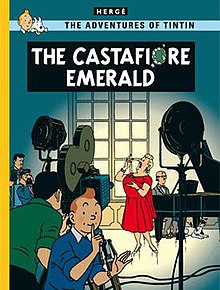The Castafiore Emerald
|
The Castafiore Emerald (Les Bijoux de la Castafiore) |
|
|---|---|

Cover of the English edition
|
|
| Date | 1963 |
| Series | The Adventures of Tintin |
| Publisher | Casterman |
| Creative team | |
| Creator | Hergé |
| Original publication | |
| Published in | Tintin magazine |
| Issues | 665–726 |
| Date of publication | 4 July 1961 – 4 September 1962 |
| Language | French |
| Translation | |
| Publisher | Methuen |
| Date | 1963 |
| Translator |
|
| Chronology | |
| Preceded by | Tintin in Tibet (1960) |
| Followed by | Flight 714 to Sydney (1968) |
The Castafiore Emerald (French: Les Bijoux de la Castafiore) is the twenty-first volume of The Adventures of Tintin, the comics series by Belgian cartoonist Hergé. It was serialised weekly from July 1961 to September 1962 in Tintin magazine.
In contrast to the previous Tintin books, Hergé deliberately broke the adventure formula he had created. It is the only book in the Tintin series where the characters remain at home in Marlinspike Hall, Captain Haddock's family estate in Belgium, and do not travel abroad or confront dangerous criminals. The plot concerns the visit of the opera singer Bianca Castafiore and the subsequent theft of her emerald.
Although The Castafiore Emerald received critical acclaim for making its characters follow a lead of false trails, it was not a commercial success due to the experimental nature of its narrative. It was published as a book by Casterman shortly after its conclusion. Hergé continued The Adventures of Tintin with Flight 714 to Sydney, while the series itself became a defining part of the Franco-Belgian comics tradition. The story was adapted for the 1991 animated series The Adventures of Tintin by Ellipse and Nelvana.
Tintin and Captain Haddock are walking through the countryside of the fictional Marlinshire when they come across a Romani community camped in a garbage dump, and reunite a lost little girl named Miarka with her family there. The Romani explain that they are not allowed to camp anywhere else so Haddock invites them to the grounds of his estate, Marlinspike Hall.
...
Wikipedia
